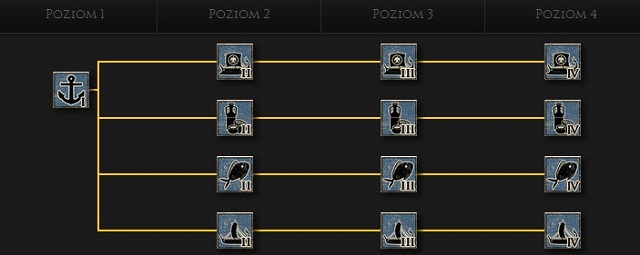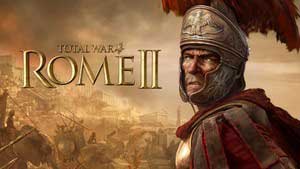Building types | Strategic map TW: Rome II Guide
Last update: 11 May 2016
There are several dozens of various types of building in the games, grouped into 9 categories. Those constructions usually have several upgrade levels increasing their productivity. In addition it is possible to use some kind of specialization of building, for example you can transform a port into a trading port or a fishing port. Not all upgrades are available for each faction - sometimes these are limited by the lack of access to local goods (such as grain).
Below you'll find a short characteristic of each buildings group along with sample development tree (based on Roman culture).
Provincial capital
This is the main building situated in every capital city. Expansion of the provincial capital increases the population growth and tax income. In addition it guarantees ever-increasing bonuses to income of other buildings located in the province. Larger capital has also stronger garrison and thicker city walls - largest metropolises have even their own war machines. Maximum expansion of the city provides bonuses to edicts. Unfortunately, the largest locations consume large amounts of food and significantly decrease public order due to galore. In order to manage 4 level capital you will need to expand a system of farms and temples.

If you have too much money and food, and there is a law and order in the location, provincial capital should be the first building to be upgraded. Additional tax revenues will pay the cost of the investment within just several (dozens) of turns! But remember to upgrade other building along with the capital, especially farms and temples.
Minor settlement
As in the case of the capital, the individual settlements can be also expanded. The higher the level of the settlement, the higher income it can generate and produce more resources, which can be sold to other factions using the trade treaty. Expanded settlements require more food (except settlements which have fish, grain and olive oil in their range) and decreases public order. In addition they do not have city walls as you can see in capital and the garrison is distinctly weaker.

Same as the capital, the settlement should be upgraded as fast as possible. Especially valuable are settlements which produce food, because they are self-sufficient and extra grain will allow feeding the population in other regions. In case of coastal locations, they will significantly increase you revenue from trade. This is the perfect opportunity to build and expand trading ports and use a proper edict.
Port
Ports can be found only in locations located directly at the sea. This building has several possible upgrades: fishing port, trading port or docks. In the case of the provincial capital located over the reservoir (e.g. Carthage), there is one more option: military wharf which allows producing the largest ships available in the game. In the most cases it is enough to have only one military wharf for several provinces - other ports can be upgraded into trading or fishing ports.

I recommend creating one military wharf in coastal provincial capital and use the rest of locations to create trading ports. In the initial phase of the game, especially in case of small coastal countries (e.g. Athens), you can try to create a net of fishing ports. As your empire grows, you should transform them into trading ports, and leave the food production to more efficient central provinces.
Agricultural
It is not hard to guess that the main task of building in this category is to produce food. A specialization available on higher levels allows you to choose a ratio between food produced to generated revenue. In case of barbarian faction, agricultural buildings allow to recruit new units (horse pens) or add various bonuses to your faction, such as loremaster's hut, which accelerates development of new technologies or reservoir reducing costs of buildings.

The biggest dilemma is always: farm or herding ground? I suggest focusing on specialization and raise farms, leaving making money to trading locations - in this way you'll also increase effects of edicts.
Religious
In this category you'll find various shrines or sacred groves. They greatly improve public order, while ensuring an access to various bonuses, starting with increased income from trade, through higher population growth, ending with improved army morale. Same as with ports, provincial capital has larger selection of buildings and is the only place where you can upgrade them up to the fourth level, and in some cases even to the unique - fifth (such as Roman Pantheon which is an extension of Basilica of Jupiter).

Temples should be built reactively: if public order decreases, you build the temple. I suggest focusing only on constructions which improve public satisfaction and promote your culture. If your goal is to stabilize the central provinces, you should also consider building shrines which speed up development of new technologies.
City center
City center can be built only in the provincial capital. This building, depending on the selected upgrade, offers a wide selection of bonuses. They can be connected both to the agricultural, trade, slaves, public order, population growth or education. In addition, city center generates quite substantial income, so it is a great addition to every province aimed at generating money.

Thanks to the possibility of converting one building into another, you can easily build city center in newly conquered provinces and then expand them into buildings increasing public order. In the future, when there is no rebellion threat, you could convert them into constructions which support trade and increase agricultural income.
Sanitation
Same as with city center, buildings in this category can be built only in provincial capital. They ensure increased population growth, improve public order and, depending on the development path, increase agents' experience level or speed up the spread of your culture. Unfortunately, these buildings consume large amounts of food.

Aqueducts are very useful in developing provinces, where not all settlements are on the maximum level of development. Increasing the population growth, they speed up the expansion of your empire. Once you reach the maximum population, you can convert them into more effective shrines.
Industrial
Industrial buildings built in the provincial capital specialize in production of goods, which increase your annual revenue. Depending on the chosen path they can also help you to construct other building in the region or ensure bonuses to trading and agricultural. In case of barbarian factions industrial buildings ensure also various upgrades for units recruited in the province: woodworker will increase amount of ammo for projectile units and bronze workshop will allow producing war chariots.

These structures complement well with trading buildings, such ports, because you can improve their efficiency with one edict. They play bigger role in barbarian factions, because in addition to generating income, they improve efficiency of particular military units - I recommend using them especially in border provinces, which are recruiting new troops.
Military
Military buildings can be divided into three minor categories: training, equipment and recruitment. First of them increases experience level and improves offensive or defensive abilities if newly recruited units. Equipment buildings offer better weapons and armors and shields - in some cases they give an access to siege machines of higher levels (Siege Engineer's Workshop). The last group of buildings increases the number of unit types available in the province. After starting a new campaign, it is this branch that will be fastest developed.

As previously mentioned, building from this category should be built mainly in border provinces to ensure continuous access to new and well-trained and equipped units. Keep in mind also, that troops' equipment can be upgraded whenever you find yourself in the location with the appropriate building and the experience gained through training buildings is a one-off - during the recruitment. Hence, it is possible to build workshops outside the provinces in which you currently recruit the troops - the only thing to lose is time, needed to march an army to upgrade weapons and armors.
